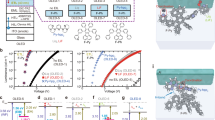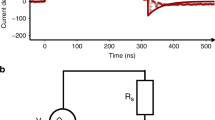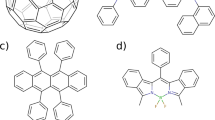Abstract
In multilayer white organic light-emitting diodes the electronic processes in the various layers—injection and motion of charges as well as generation, diffusion and radiative decay of excitons—should be concerted such that efficient, stable and colour-balanced electroluminescence can occur. Here we show that it is feasible to carry out Monte Carlo simulations including all of these molecular-scale processes for a hybrid multilayer organic light-emitting diode combining red and green phosphorescent layers with a blue fluorescent layer. The simulated current density and emission profile are shown to agree well with experiment. The experimental emission profile was obtained with nanometre resolution from the measured angle- and polarization-dependent emission spectra. The simulations elucidate the crucial role of exciton transfer from green to red and the efficiency loss due to excitons generated in the interlayer between the green and blue layers. The perpendicular and lateral confinement of the exciton generation to regions of molecular-scale dimensions revealed by this study demonstrate the necessity of molecular-scale instead of conventional continuum simulation.
This is a preview of subscription content, access via your institution
Access options
Subscribe to this journal
Receive 12 print issues and online access
$259.00 per year
only $21.58 per issue
Buy this article
- Purchase on Springer Link
- Instant access to full article PDF
Prices may be subject to local taxes which are calculated during checkout





Similar content being viewed by others
References
Kido, J., Kimura, M. & Nagai, K. Multilayer white light-emitting organic electroluminescent device. Science 267, 1332–1334 (1995).
Walzer, K., Maennig, B., Pfeiffer, M. & Leo, K. Highly efficient organic devices based on electrically doped transport layers. Chem. Rev. 107, 1233–1271 (2007).
Baldo, M. A. et al. Highly efficient phosphorescent emission from organic electroluminescent devices. Nature 395, 151–154 (1998).
Reineke, S. et al. White organic light-emitting diodes with fluorescent tube efficiency. Nature 459, 234–239 (2009).
Schwartz, G., Fehse, K., Pfeiffer, M., Walzer, K. & Leo, K. Highly efficient white organic light emitting diodes comprising an interlayer to separate fluorescent and phosphorescent regions. Appl. Phys. Lett. 89, 083509 (2006).
Reineke, S. & Baldo, M. Recent progress in the understanding of exciton dynamics within phosphorescent OLEDs. Phys. Status Solidi A 209, 2341–2353 (2012).
Bässler, H. & Köhler, A. Charge transport in organic semiconductors. Top. Curr. Chem. 312, 1–66 (2012).
Pasveer, W. F. et al. Unified description of charge-carrier mobilities in disordered semiconducting polymers. Phys. Rev. Lett. 94, 206601 (2005).
Bouhassoune, M., Van Mensfoort, S. L. M., Bobbert, P. A. & Coehoorn, R. Carrier-density and field-dependent charge-carrier mobility in organic semiconductors with correlated Gaussian disorder. Org. Elec. 10, 437–445 (2009).
Schober, M. et al. Quantitative description of charge-carrier transport in a white organic light-emitting diode. Phys. Rev. B 84, 165326 (2011).
Van Mensfoort, S. L. M. et al. Predictive modeling of the current density and radiative recombination in blue polymer-based light-emitting diodes. J. Appl. Phys. 109, 064502 (2011).
Houili, H., Tutiš, E., Lütjens, H., Bussac, M. & Zuppiroli, L. MOLED: Simulation of multilayer organic light emitting diodes. Comput. Phys. Commun. 156, 108–122 (2003).
Coehoorn, R. & van Mensfoort, S. L. M. Effects of disorder on the current density and recombination profile in organic light-emitting diodes. Phys. Rev. B 80, 085302 (2009).
Van Mensfoort, S. L. M. et al. Measuring the light emission profile in organic light-emitting diodes with nanometre spatial resolution. Nature Photon. 4, 329–335 (2010).
Li, G. et al. Combinatorial study of exciplex formation at the interface between two wide band gap organic semiconductors. Appl. Phys. Lett. 88, 253505 (2006).
Furno, M., Meerheim, R., Hofmann, S., Lüssem, B. & Leo, K. Efficiency and rate of spontaneous emission in organic electroluminescent devices. Phys. Rev. B 85, 115205 (2012).
Van der Holst, J. J. M., van Oost, F. W. A., Coehoorn, R. & Bobbert, P. A. Monte Carlo study of charge transport in organic sandwich-type single-carrier devices: Effects of Coulomb interactions. Phys. Rev. B 83, 085206 (2011).
Van Mensfoort, S. L. M., Shabro, V., de Vries, R. J., Janssen, R. A. J. & Coehoorn, R. Hole transport in the organic small-molecule material α-NPD: Evidence for the presence of correlated disorder. J. Appl. Phys. 107, 113710 (2010).
Van Mensfoort, S. et al. Electron transport in the organic small-molecule material BAlq the role of correlated disorder and traps. Org. Elec. 11, 1408–1413 (2010).
Mandoc, M. M., de Boer, B., Paasch, G. & Blom, P. W. M. Trap-limited electron transport in disordered semiconducting polymers. Phys. Rev. B 75, 193202 (2007).
May, F., Baumeier, B., Lennartz, C. & Andrienko, D. Can lattice models predict the density of states of amorphous organic semiconductors? Phys. Rev. Lett. 109, 136401 (2011).
Olthof, S. et al. Ultralow doping in organic semiconductors: Evidence of trap filling. Phys. Rev. Lett. 109, 176601 (2012).
Miller, A. & Abrahams, E. Impurity conduction at low concentrations. Phys. Rev. 120, 745–755 (1960).
Cottaar, J., Koster, L. J. A., Coehoorn, R. & Bobbert, P. A. Scaling theory for percolative charge transport in disordered molecular semiconductors. Phys. Rev. Lett. 107, 136601 (2011).
Marcus, R. A. Electron transfer reactions in chemistry. Theory and experiment. Rev. Mod. Phys. 65, 599–610 (1993).
Kawamura, Y., Brooks, J., Brown, J. J., Sasabe, H. & Adachi, C. Intermolecular interaction and a concentration-quenching mechanism of phosphorescent Ir(III) complexes in a solid film. Phys. Rev. Lett. 96, 017404 (2006).
Steinbacher, F. S., Krause, R., Hunze, A. & Winnacker, A. Triplet exciton transfer mechanism between phosphorescent organic dye molecules. Phys. Stat. Sol. A 209, 340–346 (2012).
Van der Holst, J. J. M., van Oost, F. W. A., Coehoorn, R. & Bobbert, P. A. Electron–hole recombination in disordered organic semiconductors: Validity of the Langevin formula. Phys. Rev. B 80, 235202 (2009).
Kwiatkowski, J. J. et al. Simulating charge transport in tris(8-hydroxyquinoline) aluminium (Alq3). Phys. Chem. Chem. Phys. 10, 1852–1858 (2008).
Rühle, V. et al. Microscopic simulations of charge transport in disordered organic semiconductors. J. Chem. Theor. Comput. 7, 3335–3345 (2011).
Cottaar, J., Coehoorn, R. & Bobbert, P. A. Scaling theory for percolative charge transport in molecular semiconductors: Correlated versus uncorrelated energetic disorder. Phys. Rev. B 85, 245205 (2012).
Cottaar, J., Coehoorn, R. & Bobbert, P. A. Field-induced detrapping in disordered organic semiconducting host–guest systems. Phys. Rev. B 82, 205203 (2010).
Mladenovski, S., Reineke, S. & Neyts, K. Measurement and simulation of exciton decay times in organic light-emitting devices with different layer structures. Opt. Lett. 34, 1375–1377 (2009).
Tang, K-C., Liu, K. L. & Chen, I-C. Rapid intersystem crossing in highly phosphorescent iridium complexes. Chem. Phys. Lett. 386, 437–441 (2004).
Schwartz, G., Reineke, S., Rosenow, T., Walzer, K. & Leo, K. Triplet harvesting in hybrid white organic light-emitting diodes. Adv. Funct. Mater. 19, 1319–1333 (2009).
Acknowledgements
This research was supported by the European Community (Program No. FP7-213708 (AEVIOM), M.S., M.F., B.L., K.L., P.L., R.C. and P.A.B.), the Dutch nanotechnology programmes NanoNed (J.J.M.v.d.H.) and NanoNextNL (M.M., H.v.E.), and the Dutch Polymer Institute (DPI), projects No. 518 (M.C.) and 680 (R.J.d.V.). The authors thank J. Cottaar, H. Nicolai, R. Nitsche, B. Ruhstaller, P. Blom and N. Greenham for the many discussions we had at the AEVIOM meetings and other occasions. The value of the hole mobility of α-NPD in Table 1 was established with the help of R. Nitsche. M. de Vries performed the measurements from which the parameter values for NET5 and Spiro-DPVBi in Table 1 were obtained. We acknowledge the contributions of F. W. A. van Oost to the simulation codes.
Author information
Authors and Affiliations
Contributions
M.M. and M.C. contributed equally to the work: M.M. performed the main Monte Carlo simulations and M.C. the main measurements on the OLED; R.J.d.V. determined the electron-transport parameters in Spiro-DPVBi and NET5; H.v.E. programmed the exciton diffusion software and prepared part of the figures; J.J.M.v.d.H. was involved in setting up the Monte Carlo simulations; M.S. and M.F. fabricated the OLED, provided its experimental optimization and characterization, and determined hole transport parameters, all supervised by B.L. and K.L.; P.L. was involved in the definition of the OLED stack, the UPS and optical measurements on the stack materials, and the fabrication of devices for the determination of electron transport parameters; R.C. supervised the whole project and contributed to the writing; P.A.B. supervised the simulation work and wrote the main part of the manuscript.
Corresponding author
Ethics declarations
Competing interests
The authors declare no competing financial interests.
Supplementary information
Supplementary Information
Supplementary Information (PDF 691 kb)
Rights and permissions
About this article
Cite this article
Mesta, M., Carvelli, M., de Vries, R. et al. Molecular-scale simulation of electroluminescence in a multilayer white organic light-emitting diode. Nature Mater 12, 652–658 (2013). https://doi.org/10.1038/nmat3622
Received:
Accepted:
Published:
Issue Date:
DOI: https://doi.org/10.1038/nmat3622
This article is cited by
-
Efficiency improvement of organic light-emitting diodes device by attaching microlens arrays and dependencies on the aspect ratio
Indian Journal of Physics (2022)
-
Light extraction efficiency analysis of fluorescent OLEDs device
Optical and Quantum Electronics (2021)
-
Push-pull effect on the charge transport characteristics in V-shaped organic semiconductor materials
Bulletin of Materials Science (2021)
-
High energy acceptor states strongly enhance exciton transfer between metal organic phosphorescent dyes
Nature Communications (2020)
-
Undoped highly efficient green and white TADF-OLEDs developed by DMAC-BP: manufacturing available via interface engineering
Journal of Materials Science: Materials in Electronics (2020)



